Záznam o závěrečné práci na Katedře robotiky
| Typ práce | diplomová |  |
| Datum odevzdání | 22. 05. 2009 | |
| Počet stran | 111 | |
| Studijní obor | Robotika | |
| Os. číslo | szt035 | |
| Jméno | Bc. Jan Sztefek | |
| Vedoucí | Ing. Jiří Šablatura | |
| Konzultant | ||
| Název práce | Analýza možností užití kompozitů v konstrukci robotů | |
| Analysis of Possibilities for Composite Usage in Robot Construction | ||
| Abstrakt | V úvodu diplomové práce je provedena analýza současného stavu v oblasti kompozitních materiálů. Ze specifikace možného využití kompozitů v jednotlivých ústrojích robotů je vybráno zaměření diplomové práce na aplikaci uhlíkových laminátů v konstrukci horního ramene průmyslového robotu. Dále jsou navrženy dvě varianty konstrukčního řešení horního ramene. Jejich porovnáním je vybrána optimálnější varianta, která je následně konstrukčně řešena a doložena potřebnými výpočty, 3D modelem ramene v systému Pro/ENGINEER a jeho sestavným výkresem. Návrh ramene obsahuje konstrukci laminátových dílů a jejich spojů s kovovými koncovkami. Laminátový nosný profil je porovnán s profily z konvenčních materiálů. |
|
In the introduction of this diploma thesis, the analysis of the state of the art in the field of composite materials is performed. From the specification of possible usage of composites in the individual mechanisms of robots, the scope of the diploma thesis is chosen to focus on the application of carbon fibre laminates in the construction of the upper arm of an industrial robot. Then, two alternatives for the structural design of the upper arm are proposed. Based on their confrontation, more superior alternative is selected. This alternative is structurally designed, and essential calculations, a 3D model of the upper arm in Pro/ENGINEER package and the assembly drawing of the upper arm are given. The concept of the arm includes the design of laminate components and their attachments to metal end pieces. A load-bearing laminate profile is compared with profiles made of conventional materials. |
||
| Dosažené výsledky | U navrženého horního ramene je s výhodou využit uhlíkový laminát v konstrukci nosného profilu a koaxiálních dutých hřídelů. V obou těchto případech je předběžně navržena vhodná konfigurace laminátu respektující způsob zatížení a pro spojení laminátové trubky s kovovými koncovkami je řešen lepený spoj. Ve srovnání s nosnými profily z konvenčních (izotropních) materiálů má laminátový profil téměř 6krát vyšší specifickou tuhost. Největší úskalí užití laminátů v této aplikaci představuje jejich vyšší náchylnost k poruše v důsledku nárazu. Hmotnost navrženého ramene činí 63,6 kg. Jejího snížení je možné dosáhnout optimalizací parametrů výpočtového modelu průmyslového robotu a prvků jeho konstrukce (včetně laminátových dílů). |
|
Carbon fibre laminate is used for the structure of a load-bearing profile and coaxial hollow shafts on the designed upper arm. For both these cases, a suitable configuration of laminate, taking into account a representative load case, is designed. A bonded joint is solved for the connection between a laminate tube and metal end pieces. In comparison with the load-bearing profiles made of unconventional (isotropic) materials, the laminate profile exhibits almost six times higher the specific stiffness. Higher susceptibility to damages created by impact events is, however, a great concern of laminate usage in this application. The weight of the designed arm is 63.6 kg. Further weight reduction is possible by optimising the parameters of the computational model of the industrial robot and the elements of its structure (including the laminate components). |
||


